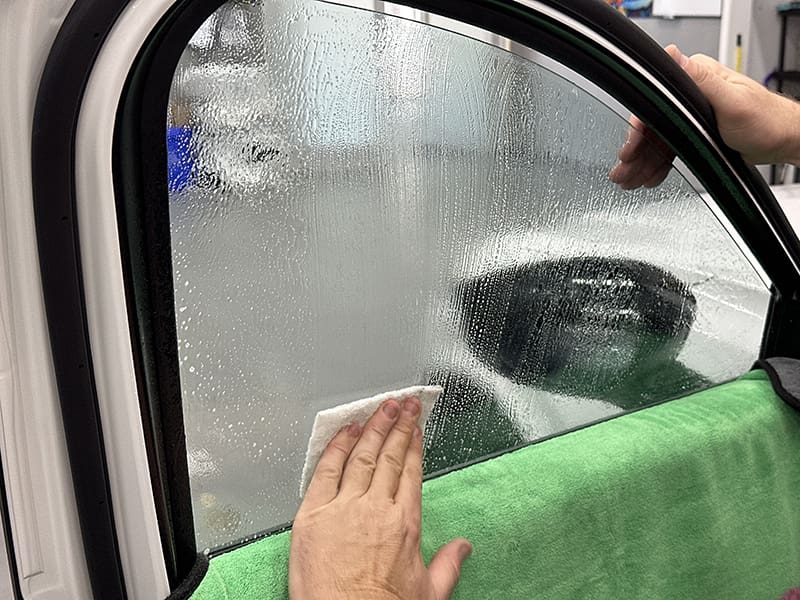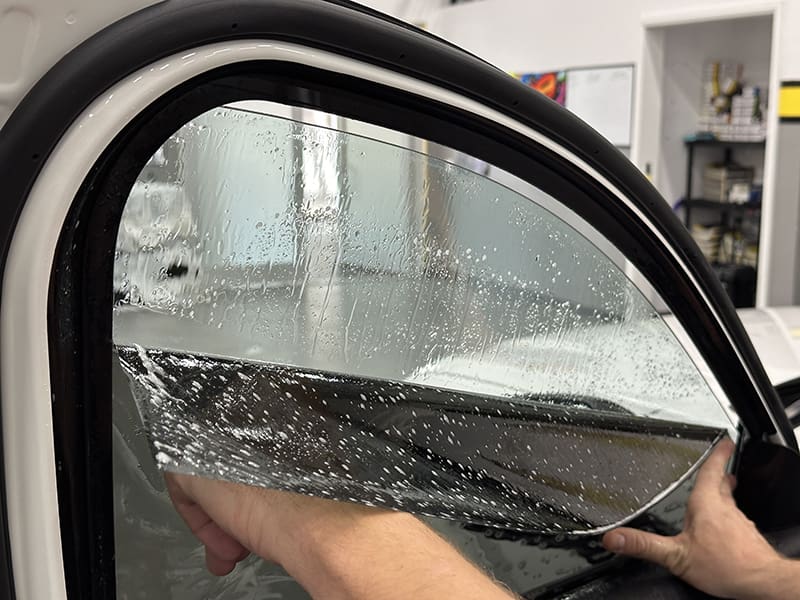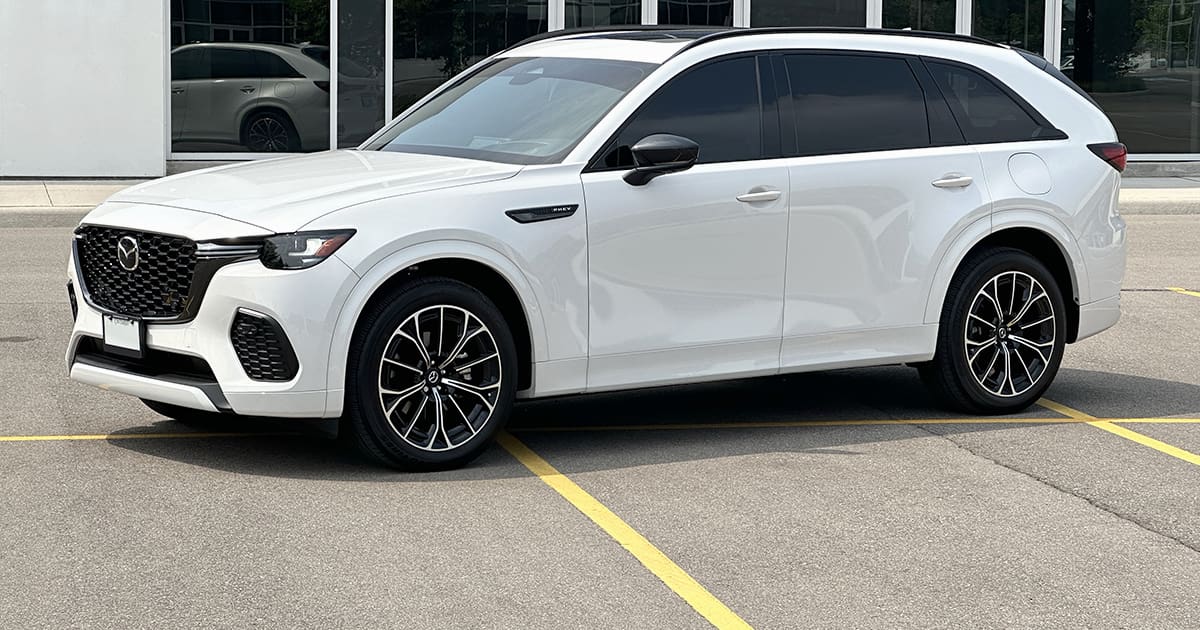A social media post last week reminded us of the importance of choosing the right person to upgrade your vehicle. While we’ll be talking about professional window tint installation, picking the right shop also applies to audio upgrades, remote car starter installations, and automotive repairs. A team member has a new SUV, so they dropped by the local Tint World to have them tint the front windows and add a visor strip across the top of the windshield.
Reasons For Tinting Car Windows
People have the windows of their cars, trucks, and SUVs tinted for one of five popular reasons. First, it can dramatically enhance the appearance of an automobile. You might have a black car or truck and want that murdered-out look, or a white car like this Mazda CX-70 and want the Stormtrooper black-on-white look.
Next, modern ceramic-based tint films do an exceptional job of blocking infrared energy from the sun. The vehicle below was tinted with a nano-ceramic film that blocks 70% of the infrared energy in the 780 to 2500 nanometer wavelength range. In short, your arm won’t feel warm when resting on the door on a bright, sunny summer day. Further, the reduction in heat transfer into the vehicle eases the load on the air conditioning system.
Vehicle Safety and Protection
Window tint can help protect your vehicle from smash-and-grab thefts. For instance, if you leave your laptop in the backseat while you run into the grocery store, tint film makes it much harder for thieves to see. As a result, they are less likely to break into your vehicle to steal anything if they can’t see it. Additionally, many films are strong enough to make it challenging to get into the vehicle after the glass is smashed. Thieves don’t want to hang around and fight with pieces of glass stuck to the film.

High-quality window tint films bond securely to the glass, and if a window breaks in an accident, the film holds the tiny pieces of glass together. This can help reduce the chances of injury from the small chunks of glass. Furthermore, the film makes it much easier to clean up if a window is broken.
Lastly, and crucially, all tint films block most of the sun’s ultraviolet energy. For instance, the XPEL film used by Tint World blocks 99% of UV energy. This protection means your body is shielded from exposure that causes wrinkles and blemishes. It’s like wearing sunscreen with an SPF of 100; however, you never need to reapply it.

Choosing a Professional for Auto Window Tint
As we mentioned in our article about items not to purchase from a car dealer, window tinting is at the top of that list. Now, it’s time to start looking for a shop to do the work. Prepare yourself with a list of questions. What is the warranty on the film they use? Do they cut the film on the vehicle or use a plotter? How clean is the shop they work in?
Let’s discuss the film warranty to break down these questions a bit. Inexpensive dyed films are notorious for fading or turning purple after a year or two. You want to pick a film that has a clear warranty that covers fading, purpling, bubbling, or peeling for the entire time you own the vehicle. You will also want to check that the warranty is covered across the country in the event that you move.
Window Tint Film Preparation
There are two ways to prepare tint for your vehicle. The technician can cut off a piece of film and put it on the outside of the glass you want tinted. They will then use a sharp knife to cut the film to shape. Done by an expert, this process works well. However, there remains a chance that the knife blade could nick the glass or trim. The modern alternative is to use a software package that includes templates for all modern vehicles. The technician will load the film you’ve chosen into a computer-controlled plotter, and it automatically cuts out the shapes for each piece of glass.
As an aside, please don’t confuse them using a plotter with a reduction in cost to do the job. While it’s true that the process is much faster, the plotter’s cost and the software’s monthly license fees aren’t insignificant.
Dust and Debris – A Tinter’s Nightmare
Finding dust between the glass and the film after window tinting is incredibly frustrating. To ensure a great installation, proper window preparation in a dust-free environment is crucial. First, clean the floor around the vehicle. Additionally, it’s your responsibility to keep your vehicle’s interior as clean as possible. If you smoke and there are ashes on the dash or door trim, the risk of something getting caught under the tint film increases exponentially. Therefore, we strongly recommend a basic interior cleaning, including a panel wipe-down and vacuuming, before arriving at the shop for tint installation.
While some technicians can do a good job, we aren’t big fans of mobile tint installations. Even the most minute of breezes can blow dust onto the windows. We strongly suggest picking a shop that has a dedicated tint bay.

The Tint Process – Film Preparation
We arrived at Tint World in Burlington, ON, to document the tint installation on this new Mazda CX-70. Mike and the store owner, Zaeem, greeted us. After finalizing the details on what shade of film to use, they pulled the vehicle into the bay while we got our cameras ready.
The technician already had the vehicle templates pulled up in the XPEL Design software and was loading a sheet of film into the plotter. All he had to do was pick the windows he wanted cut and start the plotter. While not inexpensive, plotters are indeed time-savers when it comes to automotive window tinting.

With the driver and passenger windows, along with two strips for the visor cut, the technician took the pieces of film over to the shop’s peel board. This vertical stand allows the tech to remove the release liner without risking having the film touch his clothes and pick up lint or dust particles. The transparent board is sprayed with a slip solution that holds it in place until the vehicle is ready.

The Tint Process – Vehicle Protection and Preparation
Now, the technician moves on to prepare the vehicle. In the case of this Mazda, he pulled the inner window sweeps to make it easy to get the film onto the window below where it’s seen. He covered the trim panel and switches with a towel to keep the slip solution out of any electronics.

Next, the windows are cleaned. The slip agent contains a mild surfactant to cut through the plasticizers and oils from people’s hands. They use a specific scrub pad to ensure the window will come out spotless. Not all windows are done the same way. Some have coatings that don’t respond well to this scrubbing. Tint World has the benefit of having more than 300 stores worldwide so that each location can share information on what works best on each vehicle.



The Tint Process – Installation
Now that the windows are clean, they are resprayed with a slip agent. The release liner is removed from the tint on the peel board in preparation for installation on the window.

Now, the film is brought to the vehicle. The towel has already been removed to prevent dust or lint from getting on the film. The slip agent allows the technician to fine-tune the film position on the window. It’s adjusted with a tiny gap around the edge so it won’t get caught on the rubber seals when the window rolls up or down. Some installers cut the film flush with the edge of the glass. Talk to the shop if you have a specific preference, but listen attentively to why they do their installations the way they do.



The technician will finish the process by wiping down any slip agent that has dripped onto the door trim panel. Additionally, if your vehicle has suede, Alcantara, or genuine leather, the technician tapes the blanket in place to provide protection. Furthermore, the upper tape edge (closest to the window) helps keep dust and lint away from the glass.
Expert Tools For a Perfect Installation
In the case of this Mazda, there is a very slight horizontal contour to the bottom of the window glass. The technician used a propane torch to warm the glass and film, then worked the bottom edge of the film down perfectly with the squeegee. With some cars, using heat to shrink the film for heavily curved rear windows is crucial. The same applies to windshields, though they can be stressed easily if excessive heat is applied in a specific location. Although it looks like a simple process, knowing what works and what doesn’t is part of the artistry of window tinting.

If you’ve ever had your windows tinted, you’ll know that they look bumpy and irregular for a few days to a week. There is still a small amount of slip agent between the film and the glass. It may take some time, but this will go away. Be patient, and don’t poke at it or roll the windows down. That liquid will evaporate, and the tint will look great.
Windshield Visor Tint
The process for installing the visor strips at the top of the windshield is very similar. Crucially, the technician protects the dash with a Soak Shield, an absorbent rope sewn to a microfiber dash cover. First, they force the soft, absorbent braided rope into the gap between the base of the windshield and the dash to ensure the slip agent doesn’t run down into the fragile electronics. Additionally, if you have the entire windshield tinted, using a Soak Shield is crucial to preventing water damage. Therefore, ask about this before any work begins.

The remainder of the process mirrors that for the side windows. Thoroughly clean the window with a scrub pad and wipe away debris. Apply more slip agent, place and position the film, then squeeze out the slip agent from under the film. Finally, clean the windshield, remove the towel and Soak Shield, and give the window a final cleaning.
Plan Your Project to Prevent Pain – Seek a Professional for Automotive Window Tint Installation
If you want to have the windows of your car, truck, or SUV tinted, find a local shop specializing in this service. They will carry name-brand film products with excellent warranties. Further, they will have the tools, experience, and vehicle knowledge required to install the film properly. The shop will be clean, preventing dust or debris from being caught under the film.

